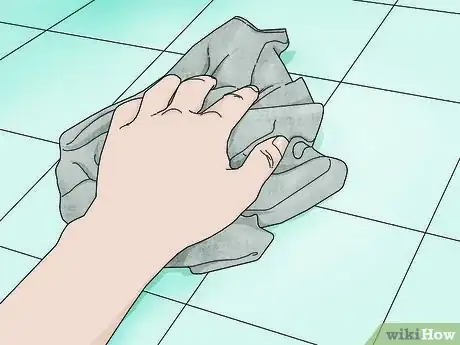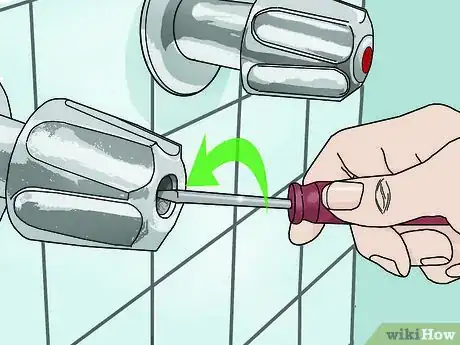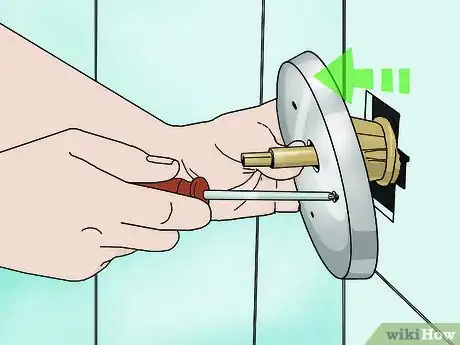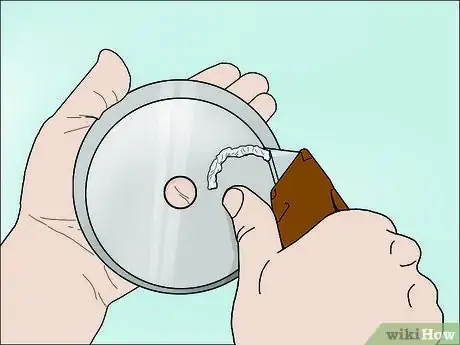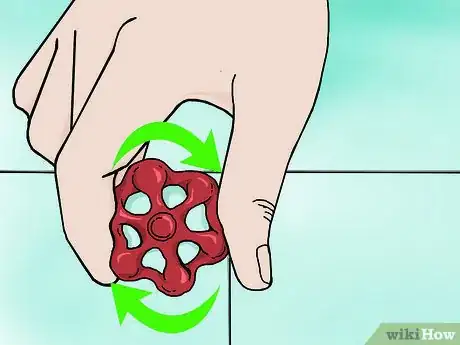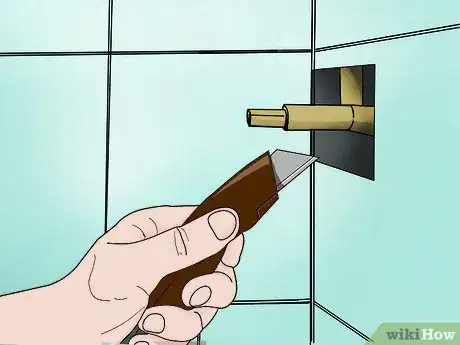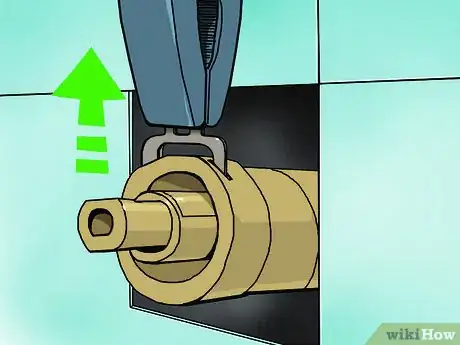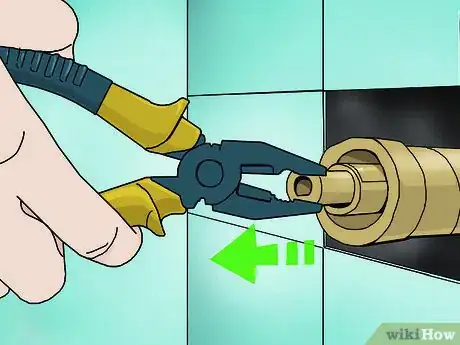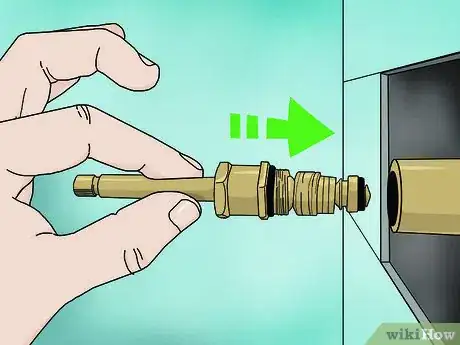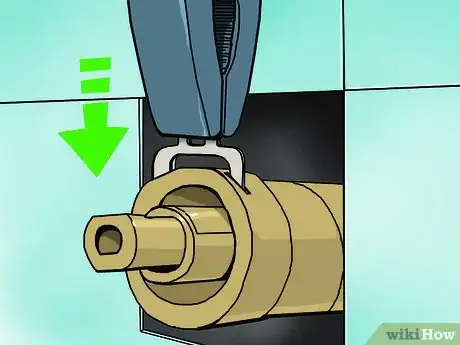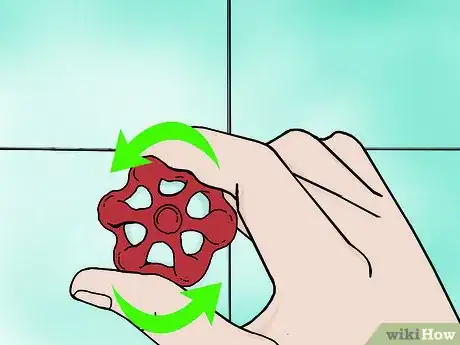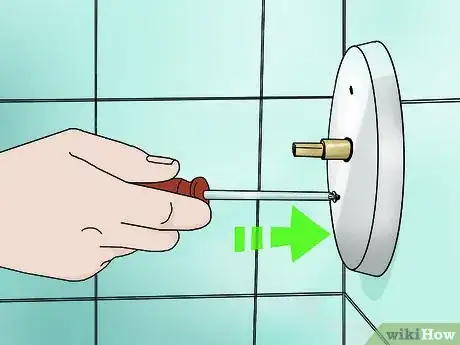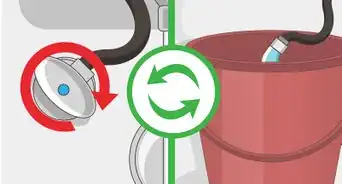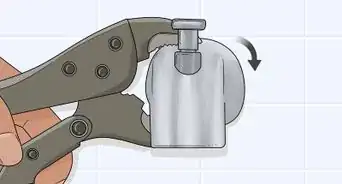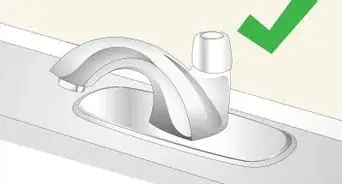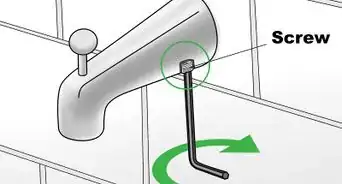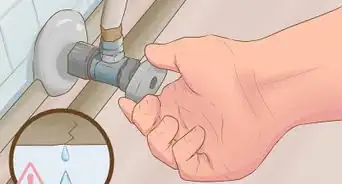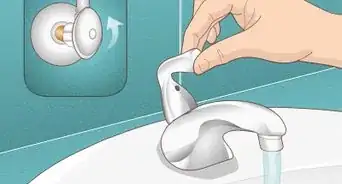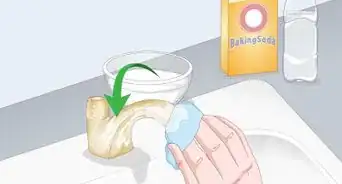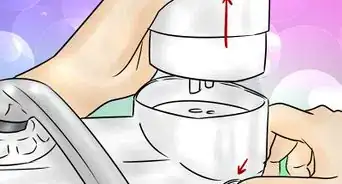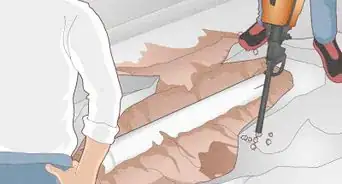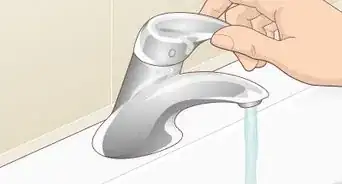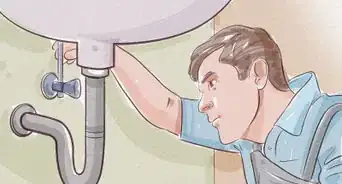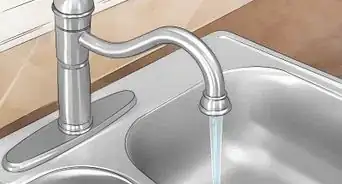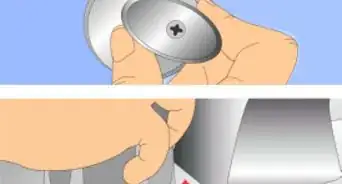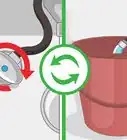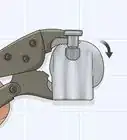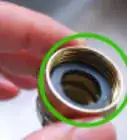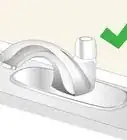This article was co-authored by Dave Jones. Dave Jones is a Professional Plumber and the Midwest Regional Vice President at Roto-Rooter Plumbing & Water Cleanup. In 1992, Jones joined Roto-Rooter as a drain service technician at the age of 18. Since then, he has risen through the ranks into positions of increasing authority. Dave served as general manager of Roto-Rooter’s Charlotte, North Carolina, and Atlanta, Georgia branches before being promoted to Contractor Area Manager and later to Regional Vice President. Dave holds Master Plumber Licenses in Pennsylvania, North Carolina, and Georgia.
This article has been viewed 246,223 times.
If your shower valve is damaged beyond repair, you may need to replace it to prevent leaks. Removing your old valve and installing a new one can take time, but with patience, a novice handyman can do it without the help of a plumber. As you replace your shower valve, work carefully to make sure you don't forget any important details.
Steps
Exposing the Valve
-
1Cover the shower drain with a washcloth. Stretch the cloth over the drain so it is blocked completely. This will prevent screws or other small parts from falling in while you work on the valve.
- As you remove screws or other parts from the shower, keep them in the same place to avoid losing them.
-
2Take the shower handle off. The shower handle usually adheres to the wall by screws. Remove the screws holding the handle in place and lift it off of the handle stem. Set the handle and screws on a flat surface to keep them aside until you're ready to screw them back in later.
- After you have the screws out, you may need to wiggle or tap on the handle to get it to slide off the stem.
Advertisement -
3Unscrew the trim plate. The trim plate should be secured to the wall with two screws. Unscrew both sides and lift the trim plate from the wall. Set it and the screws aside, preferably near the shower handle, until you need to screw it back in later on.[1]
- After you take the handle and trim plate off, you can soak it in vinegar or CLR to remove any built up grime. This will make them look new again.
- Shower trim plates are usually known as Escutcheon trim plates, in case you need to ask a home repair professional about your specific model.
-
4Remove any caulk around the trim plate, if applicable. In some cases, there may be a layer of caulk surrounding the trim plate's edges. If caulk is adhering your trim plate to the wall along with the screws, scrape it off with a utility knife and then lift the trim plate off of the wall.[2]
- You can purchase caulk online or from most home improvement stores.
Removing the Old Valve
-
1Shut the water off. Before you take the valve out, you'll need to turn off the water to prevent leaks. Locate your shower's water stops and turn them clockwise to shut them off. If your water stops are turned on and off with screws, turn the screw tightly to the left with a screwdriver.[3] [4]
- The water stops are typically found to the right and left of the valve cartridge. If there are 2 stops for hot and cold water, shut off both. Usually, the water stops will have flat head screw heads that let you turn them on and off.
- Turn off the water supply to the entire house if you cannot find the water stops for your shower.
-
2Cut an access hole to better reach the valve. After you remove the trim plate, you should see a small opening in the wall. If the wall opening is not at least 12 inches (30 cm) by 12 inches (30 cm), you will need to enlarge it. Depending on whether the wall is made of glass, drywall, tiles, or another material, you will need to cut the hole to size.[5]
- If you are unsure how to cut the opening, ask a professional repairman. You can also research how to cut a hole safely and easily into your wall's material on a verified home improvement site.
- The hole should be small enough that you can still cover it with the handle and trim plate later on. Use the trim plate as a guide for the maximum size of your trim plate.
-
3Remove the valve clip with needlenose pliers. Your shower valve should have a metal clip inserted into the top that holds it in place. Lift the clip up and out of place, setting it aside on a flat surface to prevent losing it.
- If your valve clip is not damaged, you should be able to reuse it while securing the new cartridge in place. If it is, however, your new cartridge should come with its own valve clip.
- Some valve sets are secured with a retainer nut that holds them in place. To remove the nut, hold the valve while you unscrew the nut with a wrench. You can then proceed with removing your valve.
-
4Use pliers to pull the valve out of the wall. Grip the metal end of the valve cartridge firmly and pull the valve back and out of the wall. If it gets stuck at any point, wiggle it as you go to dislodge it. After you take it out of the wall, set it aside or discard it to keep it out of the way.
- While needlenose pliers can be used for this step, it may be easier with thicker pliers.
- It's also a good idea to spray it with WD 40. Wait a few minutes, then it should slide out more easily. This will reduce the risk of damaging the valve.
Installing a New Valve
-
1Insert your new valve. Grip the end of the new valve cartridge (which should be identical to the old cartridge) with pliers and slide it back into its slot in the wall. Wiggle the cartridge back and forth if at any point it gets stuck and won't slide any further.
- If your valve cartridge will not slide into the wall or seems too small for the slot, you may have bought the wrong size. Double-check the valve size and model to make sure it matches your old cartridge.
- If you notice severe rust and corrosion while changing the shower valve, then you may need to change out the entire tub and shower valve assembly.
-
2Slide the metal clip back into place. Using your needlenose pliers, pick up the new valve's metal clip and insert it into place. It should fit in the same spot as the old valve's metal clip and be inserted from the top.
-
3Turn on the water supply. If you tightened the water stops, loosen them by turning or screwing them to the right. Turn on the water supply to the entire house if you turned off the entire water supply because you couldn't locate the stops.[6]
- Do this slowly. If something wasn’t installed correctly, you won’t want the leak to burst with water.[7]
-
4Put the trim plate and handle back in place. Set the trim plate back over the access hole and screw it in place on both sides. If it had a layer of calk securing it around the sides, apply a new layer. Screw the shower handle back in place, turn it on to make sure it works, and remove the cloth from the drain.
- If you enlarged the wall opening earlier, you should be able to put everything back in place so long as the hole is not larger than the trim plate. Fill the hole back in if you accidentally made it too large.
Expert Q&A
-
QuestionCan I replace a shower valve on my own?
 Dave JonesDave Jones is a Professional Plumber and the Midwest Regional Vice President at Roto-Rooter Plumbing & Water Cleanup. In 1992, Jones joined Roto-Rooter as a drain service technician at the age of 18. Since then, he has risen through the ranks into positions of increasing authority. Dave served as general manager of Roto-Rooter’s Charlotte, North Carolina, and Atlanta, Georgia branches before being promoted to Contractor Area Manager and later to Regional Vice President. Dave holds Master Plumber Licenses in Pennsylvania, North Carolina, and Georgia.
Dave JonesDave Jones is a Professional Plumber and the Midwest Regional Vice President at Roto-Rooter Plumbing & Water Cleanup. In 1992, Jones joined Roto-Rooter as a drain service technician at the age of 18. Since then, he has risen through the ranks into positions of increasing authority. Dave served as general manager of Roto-Rooter’s Charlotte, North Carolina, and Atlanta, Georgia branches before being promoted to Contractor Area Manager and later to Regional Vice President. Dave holds Master Plumber Licenses in Pennsylvania, North Carolina, and Georgia.
Master Plumber, Roto-Rooter Plumbing & Water Cleanup If you've got some handyman experience, sure. It's going to be a tall order for a lot of folks who don't work with their hands very often.
If you've got some handyman experience, sure. It's going to be a tall order for a lot of folks who don't work with their hands very often. -
QuestionHow do I get into the wall to access the valve?
 Dave JonesDave Jones is a Professional Plumber and the Midwest Regional Vice President at Roto-Rooter Plumbing & Water Cleanup. In 1992, Jones joined Roto-Rooter as a drain service technician at the age of 18. Since then, he has risen through the ranks into positions of increasing authority. Dave served as general manager of Roto-Rooter’s Charlotte, North Carolina, and Atlanta, Georgia branches before being promoted to Contractor Area Manager and later to Regional Vice President. Dave holds Master Plumber Licenses in Pennsylvania, North Carolina, and Georgia.
Dave JonesDave Jones is a Professional Plumber and the Midwest Regional Vice President at Roto-Rooter Plumbing & Water Cleanup. In 1992, Jones joined Roto-Rooter as a drain service technician at the age of 18. Since then, he has risen through the ranks into positions of increasing authority. Dave served as general manager of Roto-Rooter’s Charlotte, North Carolina, and Atlanta, Georgia branches before being promoted to Contractor Area Manager and later to Regional Vice President. Dave holds Master Plumber Licenses in Pennsylvania, North Carolina, and Georgia.
Master Plumber, Roto-Rooter Plumbing & Water Cleanup Look on the opposite side of the wall where the shower is located. There are often access panels for this. If you don't have an access panel, you're going to have to remove that drywall, though. If your home is super old, you may want to get an asbestos inspection done first before you do anything.
Look on the opposite side of the wall where the shower is located. There are often access panels for this. If you don't have an access panel, you're going to have to remove that drywall, though. If your home is super old, you may want to get an asbestos inspection done first before you do anything. -
QuestionWhy are there two valves to shut off if there's only one water line?
 Dave JonesDave Jones is a Professional Plumber and the Midwest Regional Vice President at Roto-Rooter Plumbing & Water Cleanup. In 1992, Jones joined Roto-Rooter as a drain service technician at the age of 18. Since then, he has risen through the ranks into positions of increasing authority. Dave served as general manager of Roto-Rooter’s Charlotte, North Carolina, and Atlanta, Georgia branches before being promoted to Contractor Area Manager and later to Regional Vice President. Dave holds Master Plumber Licenses in Pennsylvania, North Carolina, and Georgia.
Dave JonesDave Jones is a Professional Plumber and the Midwest Regional Vice President at Roto-Rooter Plumbing & Water Cleanup. In 1992, Jones joined Roto-Rooter as a drain service technician at the age of 18. Since then, he has risen through the ranks into positions of increasing authority. Dave served as general manager of Roto-Rooter’s Charlotte, North Carolina, and Atlanta, Georgia branches before being promoted to Contractor Area Manager and later to Regional Vice President. Dave holds Master Plumber Licenses in Pennsylvania, North Carolina, and Georgia.
Master Plumber, Roto-Rooter Plumbing & Water Cleanup One is for hot water and the other is for cold water. If there are no shutoff valves behind the wall, you will need to locate and turn off water to the entire home and then open a fixture to relieve the pressure and drain the water.
One is for hot water and the other is for cold water. If there are no shutoff valves behind the wall, you will need to locate and turn off water to the entire home and then open a fixture to relieve the pressure and drain the water.
Things You'll Need
- Cloth
- Screwdriver
- Pliers
- Needlenose pliers
- Shower valve
- Metal valve clip
- Caulk (optional)
References
- ↑ https://www.thisoldhouse.com/how-to/how-to-repair-shower-valve
- ↑ https://www.bobvila.com/articles/how-to-install-shower-valve-trim/
- ↑ https://www.bobvila.com/articles/how-to-install-shower-valve-trim/
- ↑ Dave Jones. Master Plumber, Roto-Rooter Plumbing & Water Cleanup. Expert Interview. 29 March 2021.
- ↑ Dave Jones. Master Plumber, Roto-Rooter Plumbing & Water Cleanup. Expert Interview. 29 March 2021.
- ↑ Dave Jones. Master Plumber, Roto-Rooter Plumbing & Water Cleanup. Expert Interview. 29 March 2021.
- ↑ Dave Jones. Master Plumber, Roto-Rooter Plumbing & Water Cleanup. Expert Interview. 29 March 2021.
About This Article
To replace a shower valve, start by unscrewing the shower handle and trim plate, so you can remove them. Then, shut the water off and cut a hole in the small opening behind the trim plate, so you can reach the valve. Using needlenose pliers, remove the valve clip and pull the valve out of the wall. From here, you can insert your new valve cartridge, which should be exactly the same as the previous one. After you've slid the new valve into its slot in the wall, put the metal clip back in place with your pliers and turn on the water supply. Finish by screwing the trim plate and shower handle back in place. For more tips, including how to keep small parts from falling own the drain, keep reading!
